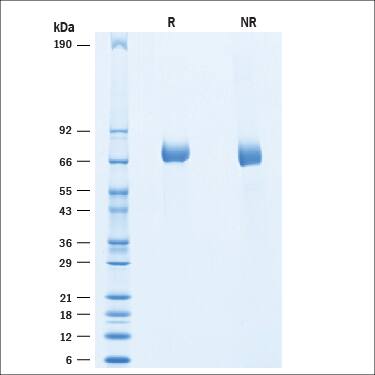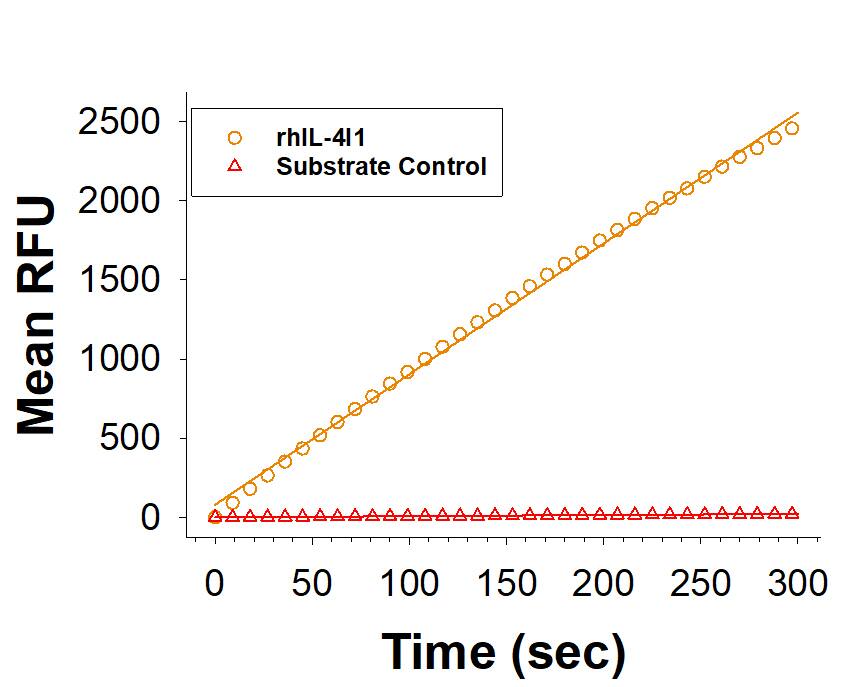Recombinant Human IL-4I1 Protein, CF
R&D Systems, part of Bio-Techne | Catalog # 5684-AO

Key Product Details
Source
Accession #
Structure / Form
Conjugate
Applications
Product Specifications
Source
Gln22-His567, with a C-terminal 6-His tag
Purity
Endotoxin Level
N-terminal Sequence Analysis
Predicted Molecular Mass
SDS-PAGE
Activity
The specific activity is >150 pmol/min/μg, as measured under the described conditions.
Reviewed Applications
Read 2 reviews rated 5 using 5684-AO in the following applications:
Scientific Data Images for Recombinant Human IL-4I1 Protein, CF
Enzyme Activity of Human IL-4I1 Protein
Recombinant Human IL-4I1 Protein (Catalog # 5684-AO) is measured by its ability to oxidize phenylalanine in a horseradish peroxidase coupled assay.SDS-PAGE of Human IL-4I1 Protein
2 μg/lane of Recombinant Human IL-4I1 Protein (5684-AO) was resolved with SDS-PAGE under reducing (R) and non-reducing (NR) conditions and visualized by Coomassie® Blue staining, showing a band at ~71 under reducing conditions.Formulation, Preparation and Storage
5684-AO
| Formulation | Supplied as a 0.2 μm filtered solution in Tris, NaCl and Glycerol. |
| Shipping | The product is shipped with polar packs. Upon receipt, store it immediately at the temperature recommended below. |
| Stability & Storage | Use a manual defrost freezer and avoid repeated freeze-thaw cycles.
|
Background: IL-4I1
Interleukin 4 induced protein 1 (IL-4I1), also known as protein FIG-1 and L-amino acid oxidase, is encoded by a B-cell IL-4-inducible gene, FIG1, and is highly expressed in primary metastinal B-cell lymphomas (1-4). It belongs to the flavin monoamine oxidase family, FIG1 subfamily. Enzymological characterization reveals that IL-4I1 has L-amino acid oxidase activity with preference toward aromatic amino acids. Studies have shown that hIL-4I1 inhibited the proliferation of CD3‑stimulated T lymphocytes with a similar effect on CD4(+) and CD8(+) T cells (5). Its inhibitory effect was dependent on enzymatic activity and H2O2 production. Its restricted expression to lymphoid tissues indicates that it may play an important function in the immune system (1, 4).
References
- Chu, C.C. and W.E. Paul. (1997) Proc. Natl. Acad. Sci. USA 94:2507.
- Mason, J.M. et al. (2004) J. Immunol. 173:4561.
- Chavan, S.S. et al. (2002) Biochim. Biophys. Acta. 1576:70.
- Copie-Bergman, C. et al. (2003) Blood 101:2756.
- Boulland, M.L. et al. (2007) Blood 110:220.
Long Name
Alternate Names
Gene Symbol
UniProt
Additional IL-4I1 Products
Product Documents for Recombinant Human IL-4I1 Protein, CF
Product Specific Notices for Recombinant Human IL-4I1 Protein, CF
For research use only

